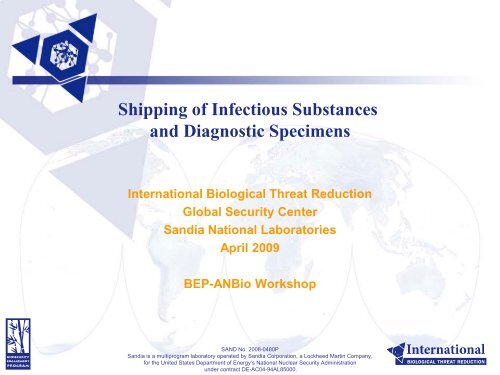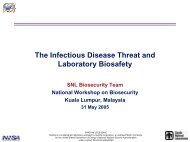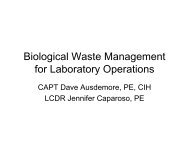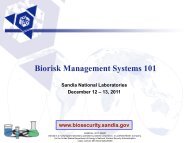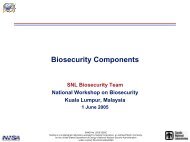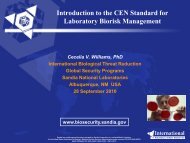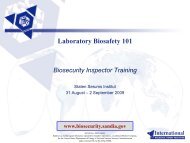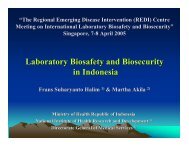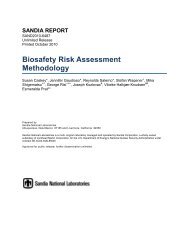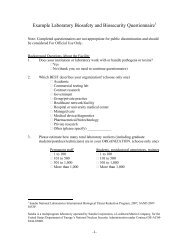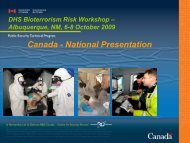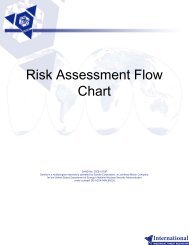Shipping of Infectious Substances and Diagnostic Specimens
Shipping of Infectious Substances and Diagnostic Specimens
Shipping of Infectious Substances and Diagnostic Specimens
You also want an ePaper? Increase the reach of your titles
YUMPU automatically turns print PDFs into web optimized ePapers that Google loves.
Material Transfer Agreement (MTA)• A material transfer agreement is a contract between the sender <strong>and</strong>recipient organizations• Defines the rights <strong>and</strong> responsibilities <strong>of</strong> each• Provides a record <strong>of</strong> the transfer• Issues with sharing materials that may be addressed in a MTA include:• Ability to publish / academic freedom• Ownership <strong>of</strong> materials to be shared• Ownership <strong>of</strong> intellectual property• Further distribution <strong>of</strong> materials• Liability3
Development <strong>of</strong> Regulations forTransport <strong>of</strong> <strong>Infectious</strong> <strong>Substances</strong>UN Transport <strong>of</strong> DangerousGoods Sub-CommitteeModel Regulations on the Transport <strong>of</strong> Dangerous GoodsADR(road)RID(rail)IMO(sea)ICAO(air)IATA(air)National Regulations6
Nine Classes <strong>of</strong> Dangerous Goods• Class 1 Explosives• Class 2 Gases• Class 3 Flammable Liquids• Class 4 Flammable Solids• Class 5 Oxidizing <strong>Substances</strong> <strong>and</strong> Organic Peroxides• Class 6 Toxic <strong>and</strong> <strong>Infectious</strong> <strong>Substances</strong>• 6.1 Toxic substances• Includes toxins• 6.2 <strong>Infectious</strong> substances• Includes cultures, pathology specimens• Class 7 Radioactive Material• Class 8 Corrosives• Class 9 Miscellaneous Dangerous Goods• Includes dry ice9
Definitions• <strong>Infectious</strong> <strong>Substances</strong>• Substance known or which is reasonably expected to containpathogens• Pathogens are microorganisms (including bacteria, viruses,rickettsiae, parasite, fungi, <strong>and</strong> other agents such as prions), whichcan cause disease in humans or animals• Divided into 2 categories: Category A <strong>and</strong> Category BChlamydiaThielaviopsisCoxiella burnetiiInfluenza A
Classifying <strong>and</strong> Identifying Samples for <strong>Shipping</strong>• The United Nations assigns a number to every type <strong>of</strong> dangerous goods• The Proper <strong>Shipping</strong> name must be used• If not exactly as in regulations, airlines will reject the package• Classification determines requirements <strong>and</strong> which Packing Instructionsmust be followed• Examples:• UN 2814 INFECTIOUS SUBSTANCES, AFFECTING HUMANS• UN 2900 INFECTIOUS SUBSTANCES, AFFECTING ANIMALS ONLY• UN 3373 BIOLOGICAL SUSBSTANCES, CATEGORY B• UN 1845 CARBON DIOXIDE, SOLID or DRY ICE• If samples <strong>of</strong> GMOs, patient specimens, regulated medical waste, orbiological products also meet the definition <strong>of</strong> infectious substances,classify as UN 2814, 2900, or 3373.• Otherwise, refer to the regulations for UN numbers <strong>and</strong> shippingrequirements.11
Determining if a Sample is Category A or Category B• Risk-based classification• Risk from a shipping perspective, not a laboratory biosafety perspective• Damage to Package• Pathogens Released• Exposure Incident• Entry to Host• <strong>Infectious</strong> Dose• Host Susceptibility• Infection• Tables <strong>of</strong> Indicative Samples <strong>of</strong> Category A; Tables not exhaustive• New or emerging pathogens meeting same criteria shall be classified asCategory A• Cultures may be Category A or B depending on microorganisms12
Category A <strong>Infectious</strong> <strong>Substances</strong>• An infectious substance which is transported in a form that, whenexposure to it occurs, is capable <strong>of</strong> causing permanent disability, lifethreateningor fatal disease in otherwise healthy humans or animals• Examples <strong>of</strong> Category A infectious substances are given in a list• List is not exhaustive13
Examples <strong>of</strong> Category A <strong>Infectious</strong> <strong>Substances</strong>
Exemptions - Examples• Blood or blood products for transfusion• Tissues or organs for transplant• Materials with low probability <strong>of</strong> containing infectious substances(foodstuffs, water samples, living persons)• However, WHO recommends that all specimens <strong>of</strong> human or animal originbe packaged in P650 as a minimal st<strong>and</strong>ard!15
<strong>Infectious</strong> <strong>Substances</strong> PackagingCategory B <strong>Infectious</strong> <strong>Substances</strong>Category A <strong>Infectious</strong> <strong>Substances</strong>• Less stringent triple packaging• No dangerous goodsdocumentation required• Packing Instruction 650• Most durable triple packaging• Full dangerous goodsdocumentation• Packing Instruction 6021616
Overview <strong>of</strong> Packaging• Triple packaging required forCategory A <strong>and</strong> B• Primary receptacle• A primary watertight, leak-pro<strong>of</strong> receptaclecontaining the specimen• Secondary packaging• A durable, watertight, leak-pro<strong>of</strong> packageto enclose <strong>and</strong> protect the primaryreceptacle(s)• Absorbent material shall be used toabsorb all fluid in case <strong>of</strong> breakage• Outer packaging• Secondary packagings are placed in outerpackagings with cushioning material• Outer packagings protect their contentsfrom physical damage while in transit• At least one external surface with aminimum dimension <strong>of</strong> 10x10 cm17
Overview <strong>of</strong> Marking <strong>and</strong> Labeling• Markings provide information on• Contents <strong>of</strong> package• Nature <strong>of</strong> hazard• Applicable packaging st<strong>and</strong>ards• Must be clearly visible• Labels – two types• Hazard labels required for mostdangerous goods• Diamond-shaped• H<strong>and</strong>ling labels required forsome dangerous goods• Various shapes• Affixed to outside <strong>of</strong> eachpackage18
Packaging, Labeling, Marking for Category A• Packaging must meet UN Class6.2 specifications (UNSpecification marking) <strong>and</strong>comply with Packing InstructionP620 (PI602)• Tests• 9 m drop test (dry, wet, -18°C,dry ice)• Puncture test• Stacking test• Internal pressure test – 95 kPa• Air Transport Maximum NetQuantity• 50 ml or 50 g per package forpassenger aircraft• 4 l or 4 kg for cargo aircraft• Markings on outer packaging oroverpack• Shipper’s name, address• Phone # <strong>of</strong> responsible person forthe shipment• Receiver’s name, address, phone #• UN number followed by propershipping name• Technical names no longerrequired – consider securityissues before including• Temperature storage requirements(optional)• If dry ice or liquid nitrogen is used:UN number <strong>and</strong> proper shippingname <strong>of</strong> refrigerant <strong>and</strong> net quantity• All applicable labels19
Category A Packaging20
Packaging, Labeling, Marking for Category B• Packaging must comply withPacking Instruction P650 (PI650)• No test documentation needed• 1.2 m drop test (dry, wet, -18°C,dry ice)• Air Transport Maximum NetQuantity• 1 l (liquids) or 1 kg (solids) perprimary receptacle• 4 l or 4 kg total per package• Markings on outer packaging oroverpack• Shipper’s name, address• Phone # <strong>of</strong> responsible person forthe shipment• Receiver’s name, address, phone #• UN number followed by propershipping name• Technical names no longerrequired – consider securityissues before including• Temperature storage requirements(optional)• If dry ice or liquid nitrogen is used:UN number <strong>and</strong> proper shippingname <strong>of</strong> refrigerant <strong>and</strong> net quantity• All applicable labels21
Category B Packaging
<strong>Shipping</strong> <strong>Infectious</strong> <strong>Substances</strong> with Dry Ice• Two options• “All packed in one fibreboard box”• UN Specification Box that holds both thesamples <strong>and</strong> the dry ice in one outerpackage. UN Specification markings arevisible on outside <strong>of</strong> this box• “Overpack used”• <strong>Infectious</strong> substances packaged in a smallerUN Specification Box that does not hold thedry ice• This smaller UN Specification Box is placedin an outer box or overpack that can hold thedry ice• Overpack is not a UN Specification Box butmust be marked• “Inner packages comply with prescribedspecifications”• All markings <strong>and</strong> labels on inside box mustalso be on overpack• Outside box must be marked with word“overpack”• Overpacks used when several packages arecombined to form one unit <strong>and</strong> sent to thesame destination by a single shipperRemember, dry ice is a Class 9 dangerous good
Required Documentation• For all shipments, consider• Is an import <strong>and</strong>/or an export permit needed?• Material transfer agreement or other agreement to share materials prior toshipping?• Documentation indicating recipient is authorized to have material?• Packing list / pr<strong>of</strong>orma invoice, which includes• Receiver’s address• Number <strong>of</strong> packages• Detail <strong>of</strong> contents• Weight• Value (for customs purposes, indicate a minimal value if items supplied free<strong>of</strong> charge)• <strong>Shipping</strong> waybill• Category A packages also require• Shipper’s Declaration for Dangerous Goods• An itemized list <strong>of</strong> contents (e.g. packing list) which is enclosed between thesecondary <strong>and</strong> outer packaging24
Facility Responsibilities in <strong>Shipping</strong>• As discussed at beginning, institution’s need system to:• Ensure appropriate approvals <strong>and</strong> paperwork in place prior to shipping• Ensure that packages are prepared in such a manner that they arrive attheir destination in good condition <strong>and</strong> present no hazard to persons oranimals during transport• Classification, Packaging, Labeling, Marking, Documentation• Control <strong>of</strong> samples prior to shipping• Which personnel are authorized to have access to the materials <strong>and</strong>information• Limited access to packages prior to h<strong>and</strong> over to carrier• E.g. secure storage for packages waiting to be picked up by carrier• Using a chain <strong>of</strong> custody may be appropriate for transport <strong>of</strong> higher securityrisk materials• Record all individuals who have contact with the dangerous pathogens <strong>and</strong>toxins up until moment package turned over to carrier25
Facility Responsibilities in <strong>Shipping</strong>, continued• Selection <strong>of</strong> an appropriate carrier that can provide appropriate security by• Ensuring reliable <strong>and</strong> trustworthy people h<strong>and</strong>le the package• Controlling access to transport facilities, docks, <strong>and</strong> vehicles• Tracking shipping progress• Providing ongoing security training for employees• Verification that recipient receives package as expected• Email or fax preferred since receipt is documented26
27Risk Perception in Transportation<strong>Infectious</strong>DiseaseOutbreakShipment <strong>of</strong> <strong>Infectious</strong>Substance (Air)<strong>Diagnostic</strong>LaboratoryAir carriers <strong>of</strong>tenrefuse shipment <strong>of</strong>infectious substancesTime Delay = Increase in deaths <strong>and</strong> greater economic damage
Summary• Many factors affect the transportation <strong>of</strong> infectious substances• Security becoming a more important concern issue• UN Model regulations revised every two years• Specific packaging requirements for international shipments• Category A vs Category B• Training requirements28


